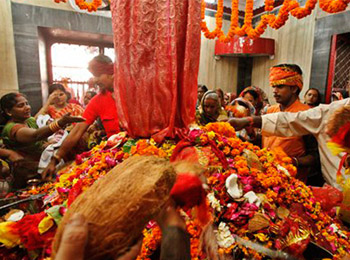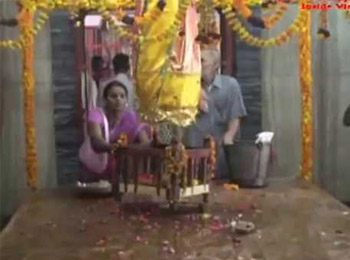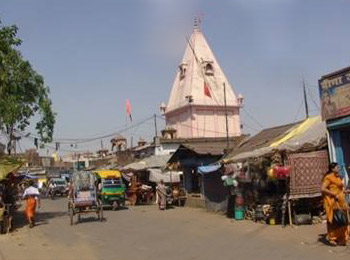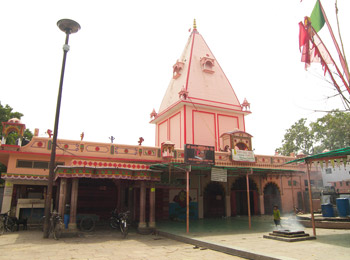- Shakti
Alopi Devi Mandir Temple
- Alopibagh,Uttar Pradesh
- View on map
- Tell us about this temple
Overview
The Sri Alopi Devi Temple is located in Alopibagh in Allahabad in state of Uttar Pradesh, India. It is near to the holy Triveni Sangam, or confluence, where the rivers Ganges, Yamuna and the legendary Sarasvati meet. Kumbh Mela is celebrated near to this place. The Madhaveswari Devi Temple at Prayag in Allahabad is additionally a standout amongst the most revered 18-Shakti Peeths. It is believed that the fingers of the hands of Goddess Sati fell at the spot where the Alopi Devi Temple stands.
About The Temple

The Shakti Peeth of Prayaga Madhaveswari is the temple where, as per the legend, Sati's fingers had fallen. It is broadly called as Mata ji ka temple (or Lalita ) by local people. Prayaga implies Prakrishta Yaga that implies it is the spot where God Brahma did a grand Yaga. Thus its name got to be Prayaga. The spot is considered as one of the Sapta (Seven) mokshapuras. This spot is additionally called as "Theertharaj" that implies lord of all theerthas. By and large the intersection of two water streams is considered as a heavenly place. Be that as it may, here one can see the juncture of three sacred streams, Ganges, Yamuna and Saraswati. All the three waterways have their significance independently. Henceforth the conjunction turned out to be sacred spot. One ought to clean up here when visiting this spot. Here Kumbhmela is celebrated at periodic intervals. There are some different stories about Alopi mata. In each temple, no less than one icon or one image is worshiped as the goddess. Be that as it may, here, there is no icon or image. The goddess is envisioned present on a wooden jhula. Thus the name Alopi. As indicated by a recent story, Alopi mata is a newly wedded spouse. She vanished from pallaki, when criminals assaulted the marriage troop. As the spouse vanished which is believed a supernatural occurrence, she is loved as Alopi mata.
This temple is unconventional in a manner that there is no statue of any Deity in this temple rather there is a wooden carriage or 'doli' which is venerated. The starting point of the name, Alopi (vanished) Bagh lies in the Hindu conviction that when after the demise of his wife Sati, the lamenting God Shiva went through the skies with her dead body. God Vishnu, to relieve him from this distress, tossed his Chakra at Sati's body, bringing about the fall of different parts of the body at different spots in India, which were blessed by the touch of the Goddess' body parts and henceforth along these lines considered heavenly places for journey. The last part fell at this area along these lines named as ''Alopi'' (where vanishing was concluded)and the holiest of all. The other all the more persuading rendition goes back to the time when the whole district was secured by thick timberlands pervaded with feared dacoits. Quite a long time ago in that backwoods happened to pass a marriage parade. Marriage parades, in those days used to be the most defenseless focuses of criminals as they used to return stacked with gold and different wealth. While deep into the wilderness this marriage gathering discovered itself surrounded by burglars. The thieves in the wake of executing every one of the men and plundering the riches swung to the 'doli' or carriage of the spouse. To their disappointment when they uncovered the carriage they found there was nobody inside. The lady had mystically vanished. The word went around, history got to be legend and legend got to be myth. A temple came up at the site where this incident had happened and the local people began worshiping the lady as ''Alopi Devi'' or the 'virgin goddess who had vanished'. Apart from this incident, this story gives no persuading clarification in the matter of why the spot would be esteemed so heavenly. Alopi Devi keeps on being worshiped by a great many individuals living in the area who share each celebration, marriage, conception and passing with their guarding divinity.
It is said and trusted that it is one of the four consecrated spots where a couple drops of the nectar 'Amritha' spilled while it was conveyed by God Maha Vishnu amid the scene of Ksheera Sagara Madhanam. The other three are Haridwar, Nasik, and Ujjain. These four spots are called theerthas and considered sacred by the Hindus. Among them Triveni Sangam (Prayaga) is viewed as the holiest and Tirtharaja. These three waterways keep up their character and are obviously distinctive as they union. While Yamuna is profound yet quiet and greenish in shading, Ganga is shallow, yet powerful and clear, Saraswati stays covered up, trust that she makes her vicinity felt submerged The centrality of Prayaga is generally known in the physical and heavenly universe. By washing in the sacred waters of the Sangam one is ridden of all wrongdoings and gets every one of his cravings satisfied. In the event that it is concurring with the Kumbh the outcomes are complex. The blessed Sangam is the site for Annual Magh Mela/Ardh KumbhaMela/Kumbha Mela. The Magha Mela is held between mid January and mid-February consistently. The Maha Kumbh Mela draws in enormous social occasions of explorers and others from everywhere throughout the world. Allahabad is world renowned for the Maha Kumbh Mela that is held once in 12 years. It is said that, more than 30 million individuals partake in the mammoth religious jamboree which should be the biggest social events of individuals on the earth.
About The Deity

Alopi Devi is an incarnation of Goddess Sati. Sati, otherwise called Dakshayani is a Hindu goddess of conjugal felicity and life span. A part of Adi Parashakti, Dakshayani is the first partner of Shiva, the second being Parvati, the resurrection of Sati herself. Goddess Alopi Devi is worshiped as a Dholi placed atop a marble stone. There is no idol of the devi, as she is said to have disappeared from the Dholi.
Legend and Stories

According to the legend, amid the period when the Goddess was occupied in destroying the Asuras, Her three principle appearances viz. Mata Maha Kali, Mata Maha Lakshmi and Mata Maha Saraswati got together one day and pooled their aggregate Tejas or otherworldly quality. A stunningly splendid light exuded from the spot where the Tejas of the three indications mixed and a lovely young lady developed out of this Tejas. The young lady asked them, ''Why have I been made?'' The Devis disclosed to her that they had made her so that she would live on earth and invest her energy in maintaining nobility. The Devis included, ''Now, go and be born as the child of of Ratankar and his wife who live in the southern piece of India, and who are incredible devotees of our own. Live on earth. Maintain honesty and advance yourself profoundly so you reach larger amounts of awareness. When you have accomplished the suitable level of awareness, you will be one with Lord Vishnu.'' So saying, they blessed the young lady. As years passed by an extremely wonderful young lady youngster was destined to Ratankar and his wife. The couple named the child Vaishnavi. The young lady right from her adolescence showed a thirst for knowledge which was similar to a vortex and which no measure of showing and learning could adequately satisfy. Accordingly, Vaishnavi began investigating her internal identity and soon started contemplating and understood that reflection and compensation just could take her near her more prominent goal. Vaishnavi in this way surrendered all family solaces and dove deep into the backwoods for Tapasaya (reflection). In the interim, God Rama, amid his fourteen years of outcast happened to visit Vaishnavi who remembered him instantly as no standard being yet the incarnation of God Vishnu, and quickly requesting that he combine her into himself so that she could turn into one with the preeminent creator.
However God Rama, realizing that it was not the suitable time, convinced her by saying that he would visit her again after the end of him being a recluse, and around then in the event that she succeeded in remembering him, he would satisfy her wish. Unswerving with his words, Rama went by her again in the wake of being triumphant in the fight, yet this time he did as such in the mask of an old man. Sadly, Vaishnavi was not able to remember him this time and was troubled. Upon this, God Rama comforted her that the fitting time for her being unified with the maker had not come, and that time would come inevitably in 'Kaliyug' when He (Rama) would be in his incarnation of 'Kalki'. Rama likewise guided her to ponder, and set up an Ashram at the base of Trikuta slopes, to elevate her level of most profound sense of being in order to favor humanity and free the poor and dejected of their sufferings. Only then would 'Vishnu' blend her into himself. Vaishnavi, quickly set off for the northern part and after enormous hardships, came to the foot of the Trikuta Hills. In the wake of coming to there she set up her ashram there and started to contemplate. As anticipated by God Rama, her radiance spread far and wide, and individuals started to rush to her Ashram to look for her blessings. As time passed, MahaYogi Guru Goraksh Nath ji who had a dream of the scene between God Rama and Vaishnavi in the review timeline, got interested to discover whether Vaishnavi possessed the capacity to achieve an abnormal state of deep sense of being or not. He, in this way, sent his most capable supporter 'Bhairon Nath' to figure out reality. Bhairon Nath on finding the ashram began watching Vaishnavi covertly, and understood that however a 'Sadhvi' she generally conveyed bow and bolts with her, and was constantly encompassed by langoors (gorillas) and a savage looking lion. Bhairon Nath was captivated by Vaishnavi's uncommon excellence, and losing all great sense he started to bother Vaishnavi to wed him. In the meantime a staunch devotee of Vaiashnavi, Mata Sridhar sorted out a Bhandara (Community dinner) in which the entire town and MahaYogi Guru Goraksh Nath ji alongside every one of his supporters including Bhairon were welcomed. Over the span of Bhandara Bhairon Nath endeavored to snatch Vaishnavi however she attempted her best to plague him. On neglecting to do as such, Vaishnavi chose to escape away into the mountains to proceed with her Tapasaya undisturbed. Bhairon Nath however pursued her to her destination. The goddess in the wake of ending at (present day) Banganga, Charan Paduka, and Adhkwari, at long last came to the heavenly give in Shrine. At the point when Bhairon Nath kept on following her in spite of the goddess attempting to stay away from a showdown, the goddess was pushed to execute him. Bhairon Nath met his definitive destiny when the goddess, simply outside the mouth of the cavern.. The separated head of Bhairon fell with a power at a far off ridge. Bhairon Nath upon death understood the purposelessness of his main goal and implored the divinity to excuse him. The god-like Mata ( Mother Goddess) showed leniency toward Bhairon and gave him a shelter that each lover of the goddess would need to have the Darshan of Bhairon in the wake of having the Darshan of the Goddess and at exactly that point would the yatra of a devotee be finished. In the meantime, Vaishnavi chose to shed off her human frame and expecting the substance of a stone she submerged herself into reflection until the end of time. Along these lines Vaishnavi, as a five and a half feet tall rock with three heads or the Pindies on the top is a definitive destination of a devotee. These Pindies constitute the Sanctum Sanctorum of the blessed cavern known as the altar of Shri Mata Vaishno Devi Ji, which is venerated by the whole gang.
Festivals
Alopi Devi Temple continues to be visited by thousands of devotees from all over the country .The festival Of Navratri is Worshipped at a grand scale here with utmost pomp and gaiety.
Best Time to Visit
August to March.
Rare Facts
The Alopi Devi Temple has an immediate connection to the Vaishnoo Devi Temple, Goddess Vaishnavi was conceived in the town encompassing the Alopi Devi Temple and this was the spot where she met God Rama
Accessibility
Airport
Daily flights available between Allahabad and Delhi, nearby Airports are Varanasi (147 kms) and Lucknow (210 kms).
Railways
The city has direct rail connections with important cities viz. Calcutta, Delhi, Patna, Guwahati, Chennai, Mumbai, Gwalior, Meerut, Lucknow, Kanpur and Varanasi.
Road
Allahabad is on National Highways 2 and 27. Distances of some important cities from Allahabad are Delhi 643km, Agra 433 km, Bhopal 680km, Varanasi 125 km, Lucknow 204 km.
Temple Address
Alopi Devi Mandir, Alopi Bagh,
Allahabad, Uttar Pradesh,
India, Pincode – 211006.
Significance
Devotees visit this temple to seek fulfillment of the following:-
- Marriage
- Get married to a person of a girl's choice
- Health and longevity of husband
Shlokas
Moola Mantra Om Dhum Durgayai Namaha
Meaning -
Sarva Mangala Maangalye Sive Sarvaardha Saadhike, Saranye Tryambake Gauri Naarayani Namosthuthe
Meaning -We offer you our salutations, Oh auspicious Naraayani, who is the good of all good, who can achieve everything and can offer refuge, Oh three-eyed Gowri.
Saranaangatha Dheenaartha Parithraana Paraayane Sarvasyaarthi Hare Devi Naaraayani Namosthuthe
Meaning -We offer salutations to you, Oh Narayani, who has the infinite power of creating, preserving and destroying. You are the basis and epitome of the 3 gunas.
Sarvaroope Sarvese Sarvasakthi Samanvithe, Bhayebhyastrahi No Devi Durge Devi Namosthuthe
Meaning -I offer my salutations to you mother Durga, who is present in all beings and has all power, save us from all our wrongdoings O mother of the universe.
